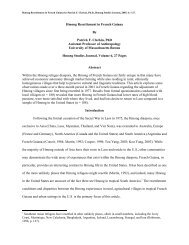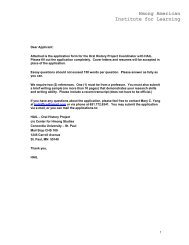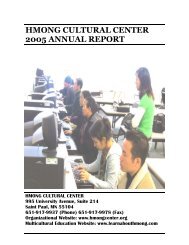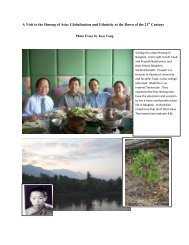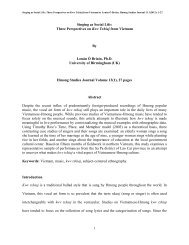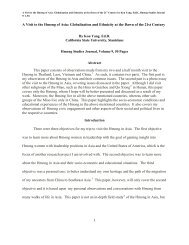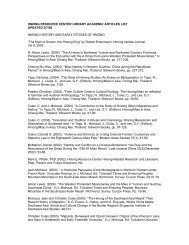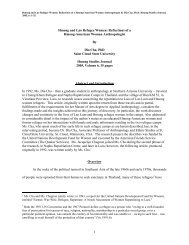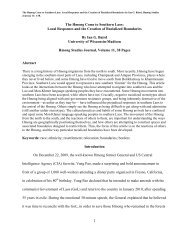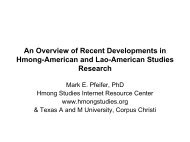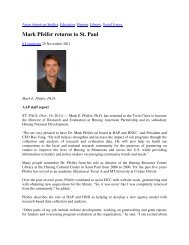What is the actual number of the (H)mong in the world? By Jacques ...
What is the actual number of the (H)mong in the world? By Jacques ...
What is the actual number of the (H)mong in the world? By Jacques ...
You also want an ePaper? Increase the reach of your titles
YUMPU automatically turns print PDFs into web optimized ePapers that Google loves.
<strong>What</strong> <strong>is</strong> <strong>the</strong> <strong>actual</strong> <strong>number</strong> <strong>of</strong> <strong>the</strong> (H)<strong>mong</strong> <strong>in</strong> <strong>the</strong> World by <strong>Jacques</strong> Lemo<strong>in</strong>e, Ph.D. H<strong>mong</strong> Studies Journal, 2005, 6: 1-8.<strong>What</strong> <strong>is</strong> <strong>the</strong> <strong>actual</strong> <strong>number</strong> <strong>of</strong> <strong>the</strong> (H)<strong>mong</strong> <strong>in</strong> <strong>the</strong> <strong>world</strong>?<strong>By</strong><strong>Jacques</strong> Lemo<strong>in</strong>e, PhDH<strong>mong</strong> Studies Journal, Volume 6, 8 pagesAbstractTh<strong>is</strong> paper syn<strong>the</strong>sizes <strong>the</strong> state <strong>of</strong> knowledge about <strong>the</strong> size <strong>of</strong> <strong>the</strong> (H)<strong>mong</strong> population <strong>in</strong>various regions <strong>of</strong> <strong>the</strong> <strong>world</strong>. Particular attention <strong>is</strong> paid to clarify<strong>in</strong>g what <strong>is</strong> known about <strong>the</strong><strong>number</strong> <strong>of</strong> (H)<strong>mong</strong> as opposed to Miao <strong>in</strong> Ch<strong>in</strong>a, an <strong>is</strong>sue which has been associated withconsiderable confusion. The author concludes by deriv<strong>in</strong>g hypo<strong>the</strong>tical estimates <strong>of</strong> <strong>the</strong> <strong>actual</strong><strong>number</strong> <strong>of</strong> (H)<strong>mong</strong> throughout <strong>the</strong> <strong>world</strong> based upon available <strong>in</strong>formation.The (H)<strong>mong</strong>, like most tribal societies around <strong>the</strong> <strong>world</strong>, have never had any prec<strong>is</strong>eidea <strong>of</strong> <strong>the</strong>ir population <strong>number</strong> from time immemorial. Wherever <strong>the</strong>y live today, <strong>the</strong>y havelearned about <strong>the</strong>ir <strong>number</strong>s by o<strong>the</strong>rs' calculation and until recently never paid much attention t<strong>of</strong>igures. They certa<strong>in</strong>ly had a sense <strong>of</strong> a <strong>number</strong> under which <strong>the</strong>y felt <strong>the</strong>ir ranks were be<strong>in</strong>gdepleted and, wherever <strong>the</strong>y were sent by <strong>the</strong> vagaries <strong>of</strong> h<strong>is</strong>tory, <strong>the</strong> pioneers a<strong>mong</strong> <strong>the</strong>m hadtwo goals <strong>in</strong> m<strong>in</strong>d: how to attract fellow tribesmen to jo<strong>in</strong> <strong>the</strong>ir group and how to reproduce andexpand <strong>the</strong>ir small communities to <strong>the</strong> po<strong>in</strong>t <strong>the</strong>y would feel at home <strong>in</strong> a foreign environment.To th<strong>is</strong> may be added that <strong>the</strong>ir own ethnicity was <strong>of</strong>ficially acknowledged only recently:<strong>in</strong> <strong>the</strong> early 70s <strong>in</strong> Laos, <strong>in</strong> 1975, <strong>in</strong> Vietnam, and <strong>in</strong> <strong>the</strong> late 70s, <strong>in</strong> Thailand, follow<strong>in</strong>g <strong>the</strong> flow<strong>of</strong> (H)<strong>mong</strong> refugees from Laos. To th<strong>is</strong> day Ch<strong>in</strong>a has still not recognized any k<strong>in</strong>d <strong>of</strong> (H)<strong>mong</strong>ethnicity nor any o<strong>the</strong>r ethnicity at all. The Ch<strong>in</strong>ese version <strong>of</strong> m<strong>in</strong>ority nationalities <strong>is</strong> an orig<strong>in</strong>alconstruction based on h<strong>is</strong>torical, l<strong>in</strong>gu<strong>is</strong>tic, cultural, economic criteria and <strong>the</strong> assumption that <strong>the</strong>groups ga<strong>the</strong>red <strong>in</strong>to one nationality would be happy to <strong>in</strong>tegrate <strong>in</strong>to such a political entity. The(H)<strong>mong</strong> <strong>of</strong> Ch<strong>in</strong>a have been trapped <strong>in</strong>to <strong>the</strong> Miao nationality <strong>in</strong> <strong>the</strong> wake <strong>of</strong> <strong>the</strong> Commun<strong>is</strong>ttakeover <strong>in</strong> 1949 toge<strong>the</strong>r with at least four o<strong>the</strong>r ethnic groups who had <strong>in</strong> common to have beenclassified as Miao by <strong>the</strong> Ch<strong>in</strong>ese writers <strong>of</strong> <strong>the</strong> Q<strong>in</strong>g dynasty. But <strong>the</strong> same Ch<strong>in</strong>ese scholars andart<strong>is</strong>ts who produced <strong>the</strong> Miao albums for <strong>the</strong> purpose <strong>of</strong> enterta<strong>in</strong><strong>in</strong>g Manchu emperors did also1
<strong>What</strong> <strong>is</strong> <strong>the</strong> <strong>actual</strong> <strong>number</strong> <strong>of</strong> <strong>the</strong> (H)<strong>mong</strong> <strong>in</strong> <strong>the</strong> World by <strong>Jacques</strong> Lemo<strong>in</strong>e, Ph.D. H<strong>mong</strong> Studies Journal, 2005, 6: 1-8.ano<strong>the</strong>r half million <strong>in</strong> <strong>the</strong> nor<strong>the</strong>rn part <strong>of</strong> <strong>the</strong> Lao People Democratic Republic..." 3Th<strong>is</strong>assertion <strong>is</strong> m<strong>is</strong>lead<strong>in</strong>g. Not only <strong>is</strong> <strong>the</strong> <strong>number</strong> <strong>of</strong> (H)<strong>mong</strong> <strong>in</strong> Lao PDR grossly exaggeratedcompared to <strong>actual</strong> censuses (231,168 <strong>in</strong> 1985; 315,465 <strong>in</strong> 1995), but a detailed account from <strong>the</strong>same 1990 Census <strong>in</strong> Ch<strong>in</strong>a, provided by Wang Fushi and Mao Zongwu 4 , shows that <strong>the</strong> <strong>number</strong><strong>of</strong> (H)<strong>mong</strong> <strong>in</strong> Ch<strong>in</strong>a at that time amounted at most to a mere 2.088 million; while <strong>the</strong> o<strong>the</strong>r Miaogroups: A Hmao (300;000), Mhu (sometimes known as Hmu or Hmub)(2.1 million) and QhoXiong (900,000) total only 3.3 million. The total <strong>number</strong> <strong>of</strong> Miao speak<strong>in</strong>g a Miao language,5.388 million leaves aside about 2 million Miao who do not speak any Miao language. Ourauthors remark judiciously that <strong>in</strong> Western Hubei, Sou<strong>the</strong>ast Sichuan and Southwest Guizhou, <strong>in</strong><strong>the</strong> (H)<strong>mong</strong> area, or <strong>in</strong> Southwest Hunan and Nor<strong>the</strong>ast Guangxi, <strong>in</strong> <strong>the</strong> Qho Xiong area, quite a<strong>number</strong> <strong>of</strong> Miao only speak a Han dialect. Some <strong>of</strong> <strong>the</strong>m, liv<strong>in</strong>g <strong>in</strong> a Dong d<strong>is</strong>trict, speak <strong>the</strong> localKam dialect and not any Miao language. In <strong>the</strong> Mhu region <strong>in</strong> Sou<strong>the</strong>ast Guizhou <strong>the</strong> Ge areadamant <strong>in</strong> adher<strong>in</strong>g to <strong>the</strong> Miao nationality <strong>the</strong>y have been granted and have struggled s<strong>in</strong>ce <strong>the</strong>beg<strong>in</strong>n<strong>in</strong>g <strong>of</strong> <strong>the</strong> nationality policy to achieve separate recognition as a Ge nationality 5 .Th<strong>is</strong> means that even if we assume that, <strong>in</strong> <strong>the</strong> best case, one million <strong>of</strong> <strong>the</strong> Miaospeak<strong>in</strong>g only Ch<strong>in</strong>ese could be part <strong>of</strong> <strong>the</strong> so-called (H)<strong>mong</strong> population <strong>of</strong> Ch<strong>in</strong>a, <strong>the</strong> total<strong>number</strong> <strong>of</strong> <strong>the</strong> (H)<strong>mong</strong> <strong>in</strong> Ch<strong>in</strong>a <strong>in</strong> 1990 could not have amounted to more than 3 million. Butone could assume as well that <strong>the</strong>se one million Han-speakers close to or acqua<strong>in</strong>ted to (H)<strong>mong</strong>clansmen may prefer to consider <strong>the</strong>mselves as Miao ra<strong>the</strong>r than (H)<strong>mong</strong> for <strong>the</strong> good reason<strong>the</strong>y feel foreign to <strong>the</strong> (H)<strong>mong</strong> communities <strong>of</strong> <strong>the</strong> various dialects <strong>the</strong>y can't speak. In that case<strong>the</strong> 1990 <strong>number</strong> <strong>of</strong> <strong>the</strong> (H)<strong>mong</strong> <strong>in</strong> Ch<strong>in</strong>a would probably be not much more than <strong>the</strong> 2.0883 Peter Kundstater, 1996: "Aspect <strong>of</strong> Change <strong>in</strong> H<strong>mong</strong> Society: Economy, Demography, Gender Statusand Marriage", Proceed<strong>in</strong>gs <strong>of</strong> <strong>the</strong> 6th International Conference on Thao Studies, Theme III, Family,Community, And Sexual Sub-Cultures <strong>in</strong> <strong>the</strong> AIDS Era, Chiang Mai, Thailand 14-17 October 1996, p.104.4 Miao-Yao yu guy<strong>in</strong> gouni "Reconstruction <strong>of</strong> <strong>the</strong> ancient pronunciation <strong>of</strong> Miao-Yao languages", Ch<strong>in</strong>eseSocial Sciences Press, Beij<strong>in</strong>g 1995, p.2-105 See, for <strong>in</strong>stance, Cheung Siu-woo: 1996, "Representation and Negotiation <strong>of</strong> Ge Identities <strong>in</strong> Sou<strong>the</strong>astGuizhou". <strong>in</strong> Mel<strong>is</strong>sa Brown ed., Negotiat<strong>in</strong>g Identities <strong>in</strong> Ch<strong>in</strong>a and Taiwan, Berkeley, Cal. Institute <strong>of</strong>East Asian Studies, University <strong>of</strong> California Press.3
<strong>What</strong> <strong>is</strong> <strong>the</strong> <strong>actual</strong> <strong>number</strong> <strong>of</strong> <strong>the</strong> (H)<strong>mong</strong> <strong>in</strong> <strong>the</strong> World by <strong>Jacques</strong> Lemo<strong>in</strong>e, Ph.D. H<strong>mong</strong> Studies Journal, 2005, 6: 1-8.million <strong>of</strong> (H)<strong>mong</strong> speakers. Th<strong>is</strong> <strong>is</strong> someth<strong>in</strong>g (H)<strong>mong</strong> travelers to Ch<strong>in</strong>a could easily verifywith <strong>the</strong>ir (H)<strong>mong</strong> clansmen. But, even th<strong>is</strong> conservative figure could also be exaggerated.Accord<strong>in</strong>g to <strong>the</strong> Ch<strong>in</strong>ese l<strong>in</strong>gu<strong>is</strong>ts, <strong>the</strong> Ch<strong>in</strong>ese (H)<strong>mong</strong> speak<strong>in</strong>g <strong>the</strong> same language as "<strong>the</strong>Miao (H<strong>mong</strong>) <strong>of</strong> Vietnam, Laos, Thailand, Myanmar <strong>in</strong> <strong>the</strong> regions neighbor<strong>in</strong>g Ch<strong>in</strong>a" are <strong>the</strong>numerous speakers <strong>of</strong> <strong>the</strong> first <strong>of</strong> three local idioms <strong>of</strong> what <strong>the</strong>y call <strong>the</strong> Chuanqiandian "subdialect",because it <strong>is</strong> spoken <strong>in</strong> <strong>the</strong> three prov<strong>in</strong>ces <strong>of</strong> Sichuan, Guizhou and Yunnan, and whichshould be considered as "(H)<strong>mong</strong> proper". However <strong>the</strong>y account for only 1.4 million. Thel<strong>in</strong>gu<strong>is</strong>ts provide also <strong>the</strong> follow<strong>in</strong>g 42 locations at <strong>the</strong> d<strong>is</strong>trict level for <strong>the</strong> speakers <strong>of</strong> th<strong>is</strong>(H)<strong>mong</strong> language:- <strong>in</strong> Sichuan: Gulan; Xuyong; X<strong>in</strong>gwen; Gongxian, Gaoxian, Changn<strong>in</strong>g, Muli TibetanAutonomous D<strong>is</strong>trict,- <strong>in</strong> Guizhou: J<strong>in</strong>sha; Ch<strong>is</strong>hui; X<strong>is</strong>hui; Renbei; Xifeng; Bijie; Nayong; Qianxi; Dafang;Zhij<strong>in</strong>; Pud<strong>in</strong>g; Pu An; X<strong>in</strong>gyi; Qian N<strong>in</strong>g Buyi and Miao Autonomous Prefecture;Anshun; Liupanshui,- <strong>in</strong> Yunnan: Qianxiong; Weix<strong>in</strong>; Yanlü; Zenshan; Yanshan; Qiubei; Maguan; Guangnan;X<strong>is</strong>hou; Malipo; Mengzi; B<strong>in</strong>gbian; Kaiyuan; J<strong>in</strong>p<strong>in</strong>g; Yuanyang; Gejiu; Mile;- <strong>in</strong> Guangxi: Longl<strong>in</strong>, Napo.Look<strong>in</strong>g at a map, we can see that <strong>the</strong>se H<strong>mong</strong> settlements constitute a very homogenousterritory extend<strong>in</strong>g from North to South at <strong>the</strong> junction <strong>of</strong> <strong>the</strong> three prov<strong>in</strong>ces down to <strong>the</strong>Vietnamese border.The o<strong>the</strong>r two local idioms belong<strong>in</strong>g to <strong>the</strong> same "sub-dialect" are to be found for <strong>the</strong>first: <strong>in</strong> Nayong, Liupanshui, and Chizhang <strong>in</strong> West Guizhou, and for <strong>the</strong> second <strong>in</strong> <strong>the</strong> suburb <strong>of</strong>Anshun and Jiuzhou, also <strong>in</strong> Anshun d<strong>is</strong>trict. Their respective <strong>number</strong>s were 84,000 and 3,000.The authors provide no <strong>in</strong>dication that <strong>the</strong>se two groups may call <strong>the</strong>mselves (H)<strong>mong</strong>.4
<strong>What</strong> <strong>is</strong> <strong>the</strong> <strong>actual</strong> <strong>number</strong> <strong>of</strong> <strong>the</strong> (H)<strong>mong</strong> <strong>in</strong> <strong>the</strong> World by <strong>Jacques</strong> Lemo<strong>in</strong>e, Ph.D. H<strong>mong</strong> Studies Journal, 2005, 6: 1-8.The same l<strong>in</strong>gu<strong>is</strong>ts, <strong>in</strong> a 1959 anonymous book for <strong>in</strong>ternal use (neibu) 6 , had given a firstdetailed account <strong>of</strong> <strong>the</strong> speakers <strong>of</strong> Miao languages – which <strong>the</strong>y called <strong>the</strong> Miao "dialects" – and<strong>of</strong> <strong>the</strong>ir dialects (for <strong>the</strong>m "sub-dialects") <strong>in</strong> exactly <strong>the</strong> same places as <strong>in</strong> <strong>the</strong>ir more recentdetailed account. At that time, <strong>in</strong> <strong>the</strong> late 50s, <strong>the</strong> total <strong>number</strong> <strong>of</strong> <strong>the</strong> (H)<strong>mong</strong> was 1.042 million.There were 100,000 A Hmao, 920,000 Mhu and 500,000 Qho Xiong. That meant a total <strong>number</strong><strong>of</strong> 2.56 million Miao speak<strong>in</strong>g a Miao language while <strong>the</strong> <strong>of</strong>ficial <strong>number</strong> <strong>of</strong> <strong>the</strong> Miao was 2.7million. Aga<strong>in</strong> some 150,000 Miao did not speak a Miao language and probably only Han 7 . Thesefigures have always seemed to me quite reliable and <strong>the</strong> Ch<strong>in</strong>ese l<strong>in</strong>gu<strong>is</strong>ts who provided <strong>the</strong>m are,needless to say, renowned scient<strong>is</strong>ts who probably wanted that <strong>the</strong>ir "<strong>in</strong>ternal" accountancy bepreserved for future researchers. They certa<strong>in</strong>ly deserve our grateful thanks. We cannot compare<strong>the</strong>ir figures to o<strong>the</strong>r sources because, so far, none o<strong>the</strong>r has ever surfaced. But we still can check<strong>the</strong>ir <strong>in</strong>ternal cons<strong>is</strong>tency.From <strong>the</strong> late 1950s to 1990, <strong>in</strong> a span <strong>of</strong> a little more than 30 years, <strong>the</strong> total <strong>number</strong> <strong>of</strong><strong>the</strong> Miao population has <strong>in</strong>creased by 174%; <strong>the</strong> <strong>number</strong> <strong>of</strong> Miao who do not speak a Miaolanguage has <strong>in</strong>creased by 1,233%. I shall come back to th<strong>is</strong> figure later. The <strong>number</strong> <strong>of</strong> (H)<strong>mong</strong>has <strong>in</strong>creased by 100%, <strong>of</strong> Qho Xiong by 80%, <strong>of</strong> Mhu by 110%, <strong>of</strong> A Hmao by 200% and <strong>the</strong>total <strong>number</strong> <strong>of</strong> Miao speak<strong>in</strong>g a Miao language by 110%. Except for <strong>the</strong> A Hmao whoexperienced a faster growth, <strong>the</strong>se figures are mutually cons<strong>is</strong>tent. The difference <strong>in</strong> <strong>the</strong> growth <strong>of</strong>population from one group to <strong>the</strong> o<strong>the</strong>r reflects, I suppose, a differential depletion <strong>in</strong> <strong>the</strong> <strong>number</strong><strong>of</strong> native speakers accord<strong>in</strong>g to <strong>the</strong> different Miao languages. The outstand<strong>in</strong>g <strong>in</strong>crease <strong>of</strong> non6 Anonymous: 1959, Zhongguo shaoshum<strong>in</strong>zu tiaocha baogao(Miao Yao yuzu bufen) Beij<strong>in</strong>g.7 I have <strong>in</strong>troduced <strong>the</strong>se figures and <strong>the</strong> classification <strong>of</strong> various Miao languages and dialects <strong>in</strong> anappendix to my book, Lemo<strong>in</strong>e: 1972, Un Village H<strong>mong</strong> Vert du Haut Laos, Par<strong>is</strong>, Editions du C.N.R.S.,p.197-199. In that first book <strong>the</strong> Ch<strong>in</strong>ese l<strong>in</strong>gu<strong>is</strong>ts obviously divided <strong>the</strong> Miao languages <strong>in</strong>to three ma<strong>in</strong>groups: H<strong>mong</strong> speakers, Mhu speakers and Qho Xiong speakers. These three language names which wererepresent<strong>in</strong>g ethno l<strong>in</strong>gu<strong>is</strong>tic groups have d<strong>is</strong>appeared from <strong>the</strong> 1995 publication <strong>of</strong> <strong>the</strong>ir 1990-1992 study,under, I suppose, a political pressure to enforce a s<strong>in</strong>gle Miao identity and <strong>the</strong>y ostensibly ignore that(H)<strong>mong</strong> identity has been recognized <strong>in</strong> SEA countries, pers<strong>is</strong>t<strong>in</strong>g to call <strong>the</strong>m Miao. Meanwhile one <strong>of</strong><strong>the</strong> o<strong>the</strong>r sub-dialects, <strong>the</strong> Nor<strong>the</strong>astern (Qiandongbei) one, I thought <strong>in</strong>cluded <strong>in</strong>to <strong>the</strong> H<strong>mong</strong> language,was <strong>in</strong> fact spoken by <strong>the</strong> A Hmao, or Dahua Miao. After v<strong>is</strong>it<strong>in</strong>g th<strong>is</strong> group, I can testify that <strong>the</strong>irlanguage, even if related to H<strong>mong</strong> <strong>in</strong> <strong>the</strong> past, <strong>is</strong> today quite un<strong>in</strong>telligible to any average H<strong>mong</strong> speaker.And <strong>of</strong> course <strong>the</strong>y have <strong>the</strong>ir own ethnic name: A Hmao.5
<strong>What</strong> <strong>is</strong> <strong>the</strong> <strong>actual</strong> <strong>number</strong> <strong>of</strong> <strong>the</strong> (H)<strong>mong</strong> <strong>in</strong> <strong>the</strong> World by <strong>Jacques</strong> Lemo<strong>in</strong>e, Ph.D. H<strong>mong</strong> Studies Journal, 2005, 6: 1-8.1500 <strong>in</strong> French Guyana, 15,000 <strong>in</strong> France and some 600 <strong>in</strong> Canada and ano<strong>the</strong>r 600 <strong>in</strong>Argent<strong>in</strong>a 10 we should have a <strong>number</strong> <strong>of</strong> about 320,000 (H)<strong>mong</strong> <strong>in</strong> <strong>the</strong> various diasporas.Thus, <strong>in</strong> all likelihood, <strong>the</strong> <strong>actual</strong> <strong>number</strong> <strong>of</strong> <strong>the</strong> (H)<strong>mong</strong> speakers around <strong>the</strong> <strong>world</strong> <strong>in</strong>2000 should have been someth<strong>in</strong>g between 4.4 and 4.5 million depend<strong>in</strong>g on whe<strong>the</strong>r one trustsor d<strong>is</strong>regards <strong>the</strong> American 2000 Census, and pend<strong>in</strong>g confirmation that <strong>the</strong> five o<strong>the</strong>r "subdialects"<strong>of</strong> <strong>the</strong> Chuanqiandian "dialect" all belong to <strong>the</strong> H<strong>mong</strong> language and ethnicity and donot hide o<strong>the</strong>r ethnic groups like <strong>the</strong> A Hmao. In that case, <strong>the</strong> <strong>number</strong> <strong>of</strong> true Ch<strong>in</strong>ese (H)<strong>mong</strong><strong>in</strong> 1990 would have been a mere 1.4 million and, if we keep <strong>the</strong> same general growth rate <strong>of</strong> 33%,<strong>the</strong>y should have been 1.862 million <strong>in</strong> 2000, lower<strong>in</strong>g <strong>the</strong> total <strong>number</strong> <strong>of</strong> <strong>the</strong> (H)<strong>mong</strong> around<strong>the</strong> <strong>world</strong> down to 3.5 million. And a rough estimation <strong>of</strong> <strong>the</strong>ir <strong>number</strong> today would vary between4 and 5 million. We are far from <strong>the</strong> 10 million some bold writers already anticipate!May I add that (H)<strong>mong</strong> and o<strong>the</strong>r scholars writ<strong>in</strong>g about <strong>the</strong> (H)<strong>mong</strong> should be morecareful <strong>in</strong> <strong>the</strong> figures <strong>the</strong>y throw at a naive audience who have no means to scrut<strong>in</strong>ize <strong>the</strong>m. Avariation from 5 to 10 million may already engender dangerous dreams such as <strong>the</strong> search for anational territory. American l<strong>in</strong>gu<strong>is</strong>ts are <strong>in</strong>nocently propagat<strong>in</strong>g illusions when <strong>the</strong>y replace <strong>the</strong>Miao-Yao Languages family by a so-called H<strong>mong</strong>-Mien Languages family enforc<strong>in</strong>g <strong>the</strong> ideathat all <strong>the</strong> Miao are (H)<strong>mong</strong> even if <strong>the</strong>y have a different ethnic name and speak a languageun<strong>in</strong>telligible to <strong>the</strong> (H)<strong>mong</strong>. In Ch<strong>in</strong>a, <strong>the</strong> Miao who are not H<strong>mong</strong>, ma<strong>in</strong>ly <strong>the</strong> Mhu and <strong>the</strong>Qho Xiong impressed by <strong>the</strong> records <strong>of</strong> (H)<strong>mong</strong> economic successes <strong>in</strong> Europe and Americahave also tried to lure <strong>the</strong> (H)<strong>mong</strong> outside Ch<strong>in</strong>a to return to <strong>the</strong> Miao fold by pretend<strong>in</strong>g thatMiao and (H)<strong>mong</strong> are only one people as can be seen <strong>in</strong> <strong>the</strong> title <strong>of</strong> a recent ComprehensiveH<strong>is</strong>tory <strong>of</strong> <strong>the</strong> Miao <strong>in</strong> Ch<strong>in</strong>a with an Engl<strong>is</strong>h subtitle "A Comprehensive H<strong>is</strong>tory <strong>of</strong> <strong>the</strong> Ch<strong>in</strong>eseH<strong>mong</strong>" <strong>in</strong> two volumes which have already been translated <strong>in</strong>to (H)<strong>mong</strong> and widely circulated10 Kaoly Yang: 1999, Naître et grandir: les processus de social<strong>is</strong>ation de l'enfant en milieu h<strong>mong</strong>, Ph. D.<strong>the</strong>s<strong>is</strong>, Université d'Aix-Marseille7
<strong>What</strong> <strong>is</strong> <strong>the</strong> <strong>actual</strong> <strong>number</strong> <strong>of</strong> <strong>the</strong> (H)<strong>mong</strong> <strong>in</strong> <strong>the</strong> World by <strong>Jacques</strong> Lemo<strong>in</strong>e, Ph.D. H<strong>mong</strong> Studies Journal, 2005, 6: 1-8.a<strong>mong</strong> <strong>the</strong> (H)<strong>mong</strong> 11 . There may ar<strong>is</strong>e a H<strong>mong</strong>/Miao transnationality as suggested by Lou<strong>is</strong>aSche<strong>in</strong> 12 but <strong>the</strong> (H)<strong>mong</strong> would be well adv<strong>is</strong>ed to th<strong>in</strong>k twice and remember <strong>the</strong> troubles <strong>of</strong> <strong>the</strong>Ge before putt<strong>in</strong>g on <strong>the</strong> flowery "All Miao" strait jacket <strong>the</strong>ir good Ch<strong>in</strong>ese Miao friends presentto <strong>the</strong>m because, <strong>in</strong> my op<strong>in</strong>ion, <strong>the</strong>re <strong>is</strong> not a s<strong>in</strong>gle chance that <strong>the</strong> opposite new "All H<strong>mong</strong>"strait jacket proposed by <strong>the</strong> l<strong>in</strong>gu<strong>is</strong>ts may ever be accepted by <strong>the</strong> Mhu or <strong>the</strong> Qho Xiong Miao<strong>in</strong> Ch<strong>in</strong>a.And <strong>the</strong> (H)<strong>mong</strong> all know that sometimes it <strong>is</strong> better to be small and free than big butbound to an unwanted match.About <strong>the</strong> Author: Dr. <strong>Jacques</strong> Lemo<strong>in</strong>e <strong>is</strong> a retired research <strong>of</strong>ficer <strong>of</strong> <strong>the</strong> French NationalCenter <strong>of</strong> Scientific Research, and now serves as a consultant for UNESCO, resource person forvarious <strong>in</strong>stitutions and Anthropolog<strong>is</strong>t Adv<strong>is</strong>or with <strong>the</strong> Institute for Cultural Research, M<strong>in</strong><strong>is</strong>try<strong>of</strong> Information and Culture, Vientiane, Lao PDR.11 Wu X<strong>in</strong>fu: 1999, Zhongguo Miaozu Tongshi A Comprehensive H<strong>is</strong>tory <strong>of</strong> <strong>the</strong> Ch<strong>in</strong>ese H<strong>mong</strong>, 1&2,Guizhou Nationalities Press.12 Lou<strong>is</strong>a Sche<strong>in</strong>: 2004, "H<strong>mong</strong>/Miao Transnationality, Identity beyond Culture" <strong>in</strong> Nicholas Tapp, JeanMichaud, Chr<strong>is</strong>itian Culas and Gary Yia Lee, ed., H<strong>mong</strong>/Miao <strong>in</strong> Asia, Chiang Mai, Silkworm8




